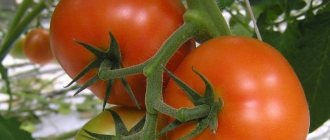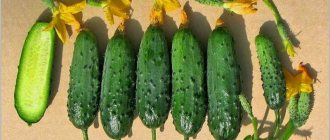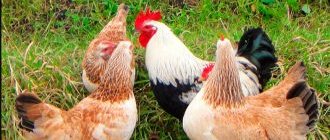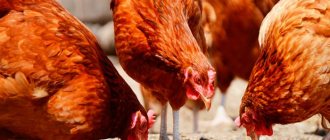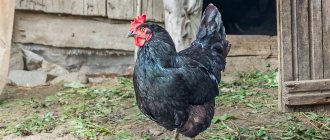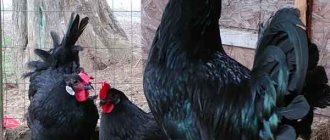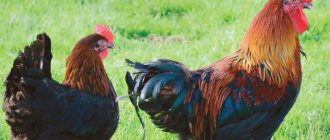The Redbrough chicken breed, or more correctly a hybrid, appeared in the UK. To create this chicken, 3 breeds were used:
- Malay fighting.
- Cornish.
- Leghorn.
As a result, thanks to such selection, a universal-purpose chicken was obtained, which shows both a good yield of meat products and high productivity in egg production.
In the publication you will find a detailed description of Redbro, see photos of this chicken, and also read reviews from farmers who met her personally.
Origin of Redbrough
These are birds with a centuries-old history. They began to be bred at the beginning of the 20th century. The birds are distinguished by their red plumage as adults, which is how they get their name. The goal of the scientists was to obtain individuals with greater weight and excellent taste of meat. Obtaining attractive representatives is only an additional bonus obtained as a result of breeding work.
The birds were bred in England. During the selection, representatives of fighting Malays and Cornish were used. Specialists from the Hubbard company, which is popular all over the world and has several branches in other countries, worked on the creation of the hybrid.
Today the hybrid has become popular and in demand among many poultry farmers. Some poultry farms have given preference to Redbro chickens for growing on an industrial scale. According to the type of performance, chicken is classified as meat-and-egg; it is considered universal.
History of the origin of the hybrid
The homeland of birds is Great Britain, where 3 breeds were used to obtain a hybrid:
- Malayan fighting dogs;
- Cornish;
- Leghorn
Birds owe their weight to fighting chickens. Redbred chickens are representatives of the meat and egg breed and therefore are universal . They are equally valued by breeders betting on eggs or meat. In private farming, universal birds are always popular.
Appearance and characteristics
Large birds are characterized by a large head, on which is located a pod-shaped or leaf-shaped crest of a bright red color. Birds have bright earlobes. The full body rests on powerful legs. The chest is slightly protruded forward. The wings are small and fit tightly to the body. The neck is thin and long, sometimes the birds resemble small ostriches.
Until the first moult, the animals are no different in appearance from ordinary chickens, which is what unscrupulous sellers often take advantage of when selling young ordinary chickens to buyers. Representatives have red plumage, sometimes turning into a red-brown hue.
A distinctive feature of birds is their calm nature. They are peaceful and rarely enter into conflicts. But at the same time, the breed is considered freedom-loving. Birds need spacious coops and space to roam. How to build a suitable chicken coop yourself - read here.
Dense plumage helps birds tolerate cold well, but it is undesirable for the temperature in the chicken coop to be low. Birds feel comfortable at 25 degrees Celsius. Otherwise, it is believed that the animal is unpretentious, making it profitable and easy to breed.
Living conditions and food
When breeding Redbro chickens, you should take into account their severity and keep the birds on the floor or on low perches.
Small wings will not be able to protect chickens from falling, so high perches with a ladder are excluded.
Day-old chicks should always have fresh cottage cheese and milk, as well as chopped herbs and a grated egg. Feeding grown Redbro chickens should include dry and moistened mash. Adult birds like vegetables and fruits. If there are fruit trees on the site, she happily pecks at overripe padanka. The diet should also include small pebbles and shell rock or chalk.
The conditions for keeping Redbro chickens do not differ from the basic principles of poultry breeding:
- spacious chicken coop;
- feeders, drinking bowls, perches;
- the presence of a container with sand or ash for dry baths, which will protect chickens from parasites;
- the straw bedding must be renewed every 5-7 days, since Redbros are very clean;
- periodic disinfection of the chicken coop;
- whitewashing walls and ceilings.
The room is treated with a 2% caustic soda solution, 4-5% creolin or 35 formaldehyde, followed by ventilation for a day or two.
The chicken coop is made no higher than 180 cm. The dimensions of the structure are calculated from the fact that per 1 sq. m. can accommodate 2 birds. The depth of the nest should be 35 cm or more, and the height should be over 30 cm. Wood shavings, straw or hay are used as bedding.
Productivity
Redbro is often called a colored broiler, because birds are prone to rapid weight gain. Already at two months the birds weigh about 2.5 kilograms. Chickens of this breed actually grow faster than regular meat and egg birds. Adult females grow up to 3 kilograms, males - up to 4.5 kilograms.
The egg characteristics of the bird are especially pleasing - the female produces up to 300 medium-sized eggs per year. The weight of one egg is 65-70 grams, the shell color is white or cream. Laying begins at 5-6 months.
general description
In most cases, the Redbro chicken breed is raised to produce a dietary meat product. The cross is practically devoid of a layer of fat, which is associated with a specific physique.
At poultry farms in European countries, 2 subspecies of birds are distinguished:
- Redbro C.
- Redbro M.
They differ only in productivity indicators and some external features.
Exterior Redbrough
Externally, Redbro chickens are distinguished by the following characteristics:
- Large head.
- Developed and powerful limbs.
- Tightly fitting feather cover.
- A scarlet ridge resembling a leaf or pod.
- Well defined muscles.
- High neck position.
- Compact wings that fit snugly to the body.
- Horizontal position of the body with a forward tilt.
- Short beak with a clear outline.
Redbro chickens are quite large, they have a large head and dense plumage.
The plumage has an intense red color, and sometimes with a brown tint. As an exception, white shades are allowed. You can distinguish a rooster from a Redbro hen by the presence of black feathers on the tail and a massive beak.
Bird temperament
Despite the large size of the body and the genes of fighting ancestors, representatives of the Redbro cross are distinguished by their peaceful and friendly character. Both males and females never conflict with individuals of other breeds, therefore they are suitable for growing together in a chicken coop.
However, birds need freedom, so keeping them in a cage is not recommended. Instead, it is better to equip a spacious poultry house with a walking yard.
Puberty
The cross is characterized by rapid puberty and rapid weight gain. At 14 days of age, Redbro chickens weigh only 300 g, and at 2 months of life their weight reaches 2.5 kg.
Redbro chickens are characterized by rapid sexual maturation.
Puberty occurs at 5-6 months. At this time, females weigh about 3.5 kg, and males - 4.5 kg.
Hatching instinct
The description of the breed mentions a developed maternal instinct. However, when breeding birds on a private farmstead, it is not used, since laying hens are not able to transfer productivity indicators to the young. The new generation of Redbro chickens has low egg production and low weight.
To obtain productive offspring, it is better to purchase young individuals from a trusted nursery or cross the cross with meat breeds.
Egg production of the Redbro breed
The egg production of colored broilers remains at an average level. The first laying of eggs begins at 5-6 months of age. However, the exact indicators may vary depending on the type of cross:
- Representatives of the Redbro M hybrid are capable of laying 193 eggs in 64 weeks. Each weighs 52 g. Peak productivity is observed within 28 weeks.
- Type S produces up to 182 eggs weighing 55 g. Maximum egg laying is observed within 29-30 weeks.
The egg production of the Redbro breed is at an average level.
For keeping at home, it is better to choose the JA57 KI hybrid, which has an egg production of 222 eggs in 64 weeks. Peak productivity lasts 28 weeks.
Shedding period
With the onset of winter, individuals of the Redbro breed begin to shed. At this time, they stop laying eggs and go to the resting stage, since when changing plumage, the body is greatly depleted and needs to be restored.
Content
The birds are kept in a regular poultry house, with the required number of perches, feeders and drinkers placed in it. Useful tips:
- The poultry house must have containers with ash and sand - chickens take dry baths in these components, which provides them with excellent protection against the appearance of parasites.
- Redbros are considered clean birds. For this reason, it is necessary to regularly clean the poultry house - at least once a week.
- Timely vaccination of the entire livestock is important. The farmer will also have to disinfect the premises.
- The ceilings and walls of the poultry house are whitened with lime and left for a day for ventilation. After this, chickens are placed there.
The poultry house should be spacious and light. It is built so that the height is no more than 180 centimeters. There are no more than 20 birds per 10 square meters. It is necessary to arrange perches on the back wall of the chicken coop, about 7 centimeters thick, otherwise it will be uncomfortable for the birds to sit on them.
A prerequisite is the equipment of nests for laying hens, clean and dry flooring, an aviary for birds - here they will walk and eat pasture.
Breed characteristics
For someone who is new to poultry farming, it is quite difficult to distinguish redbrown chickens from ordinary broiler species; they do not have any characteristic features in their appearance. However, with a careful approach, it is quite possible to reject a “fake”. External and physiological data, the direction of productivity and the character of these birds are also determined by the conditions of their keeping. It is also worth paying attention to their productivity indicators so that the farm is profitable.
Appearance
Redbro is distinguished by its large body size and well-developed muscles. The muscles throughout the body are clearly visible and palpable under the feathers. The plumage has a dark red color, which in places can turn into reddish brown. The birds' heads are small and round in shape. The comb has a leaf-like outline and is medium in size. The color of both the comb and the earrings (they are large and clearly visible) is bright red, almost crimson.
Sometimes you can find redbreasts with white plumage, but this indicates deviations in the gene pool. It is not worth culling such birds, but it is not recommended to obtain offspring from them.
The main distinctive, signature sign of red broilers is strong, powerful legs. The limbs are widely spaced and have well-developed metatarsals. The toes are mobile and strong, which is necessary to maintain the balance of a heavy carcass.
Advantages and disadvantages
The Redbro chicken breed has a number of significant advantages:
- rapid weight gain;
- large yield of tasty dietary meat;
- significant percentage of young animals survival;
- good egg production;
- unpretentiousness in nutrition.
However, red broilers also have disadvantages. These include, first of all, weak immunity and frequent illnesses. These birds resist infections, but their productivity drops by more than 40%. The appearance of the breed is also problematic - it can easily be confused with simple outbred chickens. Unscrupulous sellers take advantage of this fact.
Character
The temperament of these birds can be attributed to a number of their advantages.
Redbros are friendly and get along easily with both members of their own species and other breeds of poultry.
They are not shy, calmly experience changes in place and weather conditions, and easily make contact with people (this greatly simplifies the process of leaving). Unlike most broilers, this variety is very active and freedom-loving, and does not tolerate breeding in cramped cages or small chicken coops.
Where was it bred?
This breed was developed relatively recently, which is the reason for its unpopularity. However, every year more and more farmers pay attention to this productive type of poultry. The historical homeland of the cross is Great Britain, but work to improve the species was carried out (and is being carried out today) in France and the USA. In these same countries, they are engaged in the widest breeding of redbreasts, and I organize entire farms on their basis.
Birds molt
Like other broilers, red chickens are prone to annual molting, but for them this process is quick and less painful. This is the only period of the year when laying hens retire and stop laying eggs. The rest of the time, egg production practically does not decrease.
This hybrid has good health and a high survival rate, but during the molting period this can be a problem. The farmer will have to organize the most favorable conditions and excellent nutrition for the birds.
Regarding the lifespan of birds, it makes no sense to keep them for more than 2-3 years. Poultry farmers usually send them to slaughter when the birds are two years old - further maintenance is not justified in terms of profit.
Advantages and disadvantages
The positive features of the breed are:
- resilience at all stages of life;
- gain maximum weight in a short period;
- dietary qualities of meat;
- egg production comparable to egg breeds;
- peacefulness.
Birds have no disadvantages. For private breeders, the disadvantages of chickens are as follows:
- only industrial breeding - a hybrid cannot be created at home;
- simple appearance, which allows unscrupulous sellers to slip in counterfeit goods.
You should only buy poultry from a trusted place.
Feeding and diet
Due to today's demands for chicken meat, which must be obtained from free-roaming birds, Hubbard began to produce crosses that can live like country birds. Redbro crosses really do not require a special diet.
The chickens are fed according to the same system as the chicks of a regular laying hen. In the first days, food rich in protein is introduced into the diet. After a few weeks, they are transferred to the diet of adult birds. The owner can independently decide what to feed the animals. Redbros can eat both industrial feed and home-prepared grain mixtures and wet mash.
In order for one individual of the Redbro breed to be satisfied, the amount of feed is increased gradually depending on the age of the bird. At two weeks, babies are fed 100-150 grams of food, at three weeks the volume is increased by 50 grams. At the age of 30 days, chicks are given at least 200 grams of food, and six-month-old individuals eat portions of about 300-350 grams.
When free-ranging, birds can forage for their own greens. In winter, you will need to introduce finely chopped vegetables and root vegetables into your diet.
Raising chickens
Young animals of this breed require high-quality care. They begin to feed the chickens only after they have dried out after birth.
Initially, babies are fed a hard-boiled and well-chopped egg. Day-old chicks should also have access to boiled water. Many give either a weak solution of potassium permanganate, or water with an antibiotic diluted in it.
From the second day of a bird’s life, cottage cheese and wet mash are added to its diet. You can use special starter feed for young animals, which can be purchased in specialized stores.
We recommend reading: Description of the Adler Silver chicken breed
To prevent crusts from developing rickets, you need to add foods that contain large amounts of calcium to your diet. Alternatively, you can purchase special supplements, which are also sold in specialized stores.
Breeding and caring for chickens
Redbro chickens are excellent for breeding. But for this, it is recommended to purchase day-old chicks from conscientious poultry farmers, the cost of which varies within 50 rubles per individual. It is also acceptable to use eggs for an incubator. If the farmer does not want to use hens for rearing, it is better to place the eggs in an incubator. But for this it is important to follow certain rules so that the survival rate of chicks is high:
- Choose eggs of the same size; they should be free of any defects, including contamination. The eggs are wiped with a rag previously soaked in potassium permanganate.
- It is advisable to place eggs in the incubator in the evening to increase the likelihood of babies being born not at night, but during the day or in the evening.
- The humidity level in the incubator should not be less than 75%, and the temperature of +39 degrees is the indicator for egg content in the first 11 days.
- For the next 7 days in the incubator, the air temperature should be +38.5 degrees, humidity - up to 50%.
- For the remaining three days, the eggs in the incubator are kept at temperatures up to 37.5 degrees.
At the last stage, be sure to open all ventilation ducts in the room, which will ensure good ventilation.
The color of born chicks is light brown, their weight is about 40 grams. They are able to quickly gain weight. In just 1 month they gain about 1 kilo in weight. The hatched chicks are not yet very susceptible to external conditions, which is why the farmer needs to create comfortable conditions for them. In order for the birds to get stronger and adapt faster, follow these recommendations:
- At first, keep the babies in a box with warm bedding on the bottom. On the first day the temperature should be 30-32 degrees. Then it is reduced weekly by 2 degrees. By the 30th day of birth, chicks must be kept at a temperature of 18 degrees.
- A prerequisite for chicks in the first two days is round-the-clock lighting. Then they will have enough lighting for 13-14 hours.
- Babies are fed in the same way as broiler chicks.
It is unacceptable to start feeding chickens solid food too quickly - this can cause digestive problems.
Young animals of the Redbro breed
Newborn chicks have light brown plumage and weigh about 40 g. At the same time, they are characterized by intensive weight gain and within 30 days from the moment of birth their weight reaches 1 kg. Hatched individuals remain vulnerable to negative environmental influences and require careful care.
Young animals of the Redbro breed have light brown plumage.
Diseases, treatment and prevention
The advantages of the breed include its strong immunity and increased resistance to various diseases. Among the main ones are the following diseases:
| Disease | Symptoms | Treatment/Prevention |
| Typhoid | A dangerous disease in which birds experience a disorder of the digestive system. Usually chickens refuse to eat, they begin to have loose stools, and their body temperature rises. The birds look weak. If you do not isolate a sick individual in time, there is a risk of infecting the rest of the birds in the chicken coop - this disease is transmitted by airborne droplets. | Antibiotics are used for treatment. |
| Coccidiosis | A disease transmitted through parasites through direct contact. The bird suffers from diarrhea, it shows apathy, and its body temperature rises. | To combat parasites, special medications are used - they are prescribed by a veterinarian. The medicine is given to birds along with food or drink. |
| Pasteurellosis | Very often, Redbro chickens are exposed to this disease. A farmer can tell that a bird is infected by decreased activity, increased body temperature, a change in the color of the comb and ears, and the appearance of mucous discharge from the sinuses. | Birds are treated with drugs from the sulfonamide group. Along with treatment, the poultry house must be treated. |
| Salmonellosis | If vaccination is not carried out in a timely manner, the disease can destroy the entire livestock. When infected, birds become weak, refuse to eat, stop growing, and develop loose stools and swelling in the eye area. | To combat the disease, a solution of furazolidone is used - it is added to water. They continue to feed the birds for 10 days. |
Immunity
This is a fairly strong chicken, but it may encounter the following diseases:
- Dyspepsia is a disorder of the normal functioning of the stomach. This disease most often occurs in young birds, which are very early transferred to roughage, which is very difficult for chickens to digest. In adults, dyspepsia most often occurs due to the fact that they drink dirty water. Symptoms of the disease: diarrhea with pieces of undigested food, elevated body temperature, full belly. This disease is treated by changing the chicken's diet. In the case of dirty water, it is temporarily replaced with a weak manganese solution.
- Crop atony - this disease occurs due to the accumulation of food in the crop. The accumulation creates an obstruction. If this problem is noticed, it must be resolved immediately. Otherwise, the respiratory tract may be pinched, which will lead to the death of the bird. A symptom of goiter atony is a hard and sagging goiter. A bird with this disease is treated as follows: a little oil is instilled into its crop and a light massage is performed, which is aimed at extracting the contents of the crop.
- Vitamin deficiency is a common disease that broilers and chickens kept in cages often encounter. With vitamin deficiency, inhibited weight gain, lethargy of the bird, baldness, etc. are observed.
- Bronchopneumonia - occurs due to severe hypothermia. Symptoms of this disease: rapid breathing, loss of appetite, and the formation of mucus in the beak. To treat bronchopneumonia, penicillin or terramycin is used.
In addition to diseases, chickens may encounter parasitic diseases, such as:
- Helminth infestation. There are a wide variety of helminths, and accordingly, the symptoms can also vary depending on what parasites the bird is infected with. Common symptoms of helminth infestation include diarrhea and an anxious state in the bird.
- Trematodes. These pests significantly reduce the productivity of Redbro. Also, because of this parasite, the chicken may lay eggs that will not have a shell. Symptoms of the disease: inflamed cloaca, anxiety, apathy. They get rid of this parasite using carbon tetrachloride.
- Down and feather eaters. These are very common pests that can infest any poultry without exception. As you might guess from the name, parasites eat away the feathers and down of chickens, leaving bald spots all over their bodies. Pests can strip a hen of most of her plumage. Pests are destroyed using special insecticidal preparations.
Pros and cons of Redbro
The Redbro breed has many advantages, which is why they are especially appreciated by farmers who choose the breed for breeding.
The following qualities of animals are distinguished:
- Precocity. Already at 5 months, birds reach sexual maturity and begin to actively work. They often produce up to 300 medium-sized eggs per year. But some poultry farmers have noticed that white broiler chicks grow much faster than Redbro. But at the same time, red birds consume less food.
- Good adaptability to any conditions. Birds of this breed are able to acclimatize anywhere. The only difference between a free-ranging chicken is that its meat is much tastier than that of a bird kept in a confined space.
- Unpretentiousness in food. Birds are able to tolerate local feed very well. For this reason, the breed is considered easy and simple to breed.
- Frost resistance. At a temperature of -5 degrees, birds can walk outside without any harm to their productivity.
- Fast shedding. The molting process in Redbro birds is faster and less painful than in representatives of other breeds.
- Endurance and good health. Redbros rarely suffer from colds and do not require many vaccinations.
- Great character. Representatives of this breed have a calm temperament, which is why they are kept with birds of other breeds. Individuals do not show aggression either towards animals or towards their owner.
The breed has no significant disadvantages. The only negative quality is that they look like ordinary poultry, which is why unscrupulous sellers often deceive buyers.
Redbro chickens: description of the breed
It will be extremely difficult for a newcomer to the poultry farming business to distinguish redbrown chickens from ordinary domestic laying hens, which is largely due to the unassuming external features of the breed.
Redbrough is a large breed of bird. The chicken's head is large, the plumage is dense. Laying hens have a short, well-defined beak and a bright red crest. The shape of the ridge is leaf-shaped or pod-shaped. The earlobes are bright, making them not difficult to notice.
The color of the feathers is red, sometimes turning into red-brown. In rare cases, birds with white plumage are found, but this color of feathers is considered the exception rather than the rule.
Redbrow chickens are extremely friendly, endowed with a calm and peaceful character, which makes them easy to keep with other birds. When breeding this breed, it is better not to use cages. Redbros are extremely freedom-loving, so a spacious chicken coop with free access to range is more suitable for keeping them.
The minimum temperature in the chicken coop should not fall below 7 degrees and rise above 25. Otherwise, chickens are more than unpretentious, they are much easier to keep than other breeds, including broilers.
Industrial farms or household plots
Redbro chickens are universal, the birds feel at ease both on an ordinary personal plot and on a large poultry farm. They are most often bred to obtain a large number of eggs. At the same time, this breed belongs to the egg-meat breed, and is in great demand precisely for these qualities.
In Europe and America, redbred chickens are raised on a large scale, and veterinarians monitor the purity of the breed, which is practically impossible in homestead conditions.
Redbred chickens in a pen
Breeding redbred chickens is quite a profitable business. The weight of adult chickens reaches 3 kilograms, roosters - 4.5 kilograms, and birds reach this weight by 4-5 months of being kept on regular feed.
On average, one adult chicken can lay up to 160 eggs per year. But some laying hens may have improved egg-laying qualities, allowing them to collect up to 250-300 eggs per year.
Redbrown chicken eggs are medium in size, the color of the eggs is white or light beige. The weight of the egg is at least 60-70 grams.
Feed consumption per day
To feed one bird, aged:
- from 2 weeks you need at least 100-150 grams of feed per day;
- a three-week-old chicken consumes around 180-200 grams of feed;
- a month-old chicken consumes at least 200-220 grams per day;
- a chicken aged 5-6 weeks needs an average of 230-240 grams of feed;
- a chicken from 7 to 8 weeks must eat at least 245-250 grams of feed;
- A six-month-old chicken should be fed 300-350 grams of feed per day.
How much feed per egg?
To get 1 egg, a chicken needs to eat at least 50 grams of grain, 30 grams of wet mash, 100 grams of boiled potatoes, 10 grams of cake, 10 grams of hay flour, 100 grams of milk, a few pinches of chalk and table salt. Having a constant source of clean water is mandatory.
Feeding redbro chickens
Reviews about the breed
On the Internet you can find a variety of reviews about the Redbro breed. Some speak positively about birds, while others are indignant that they are not so unpretentious.
★★★★★
Anna, 47 years old, housewife. Once I saw red chickens in an ad; it was written that they were the Redbro breed.
I’m not sure that the seller is conscientious, because when my chickens grew up, I did not notice their high egg production, as indicated in the description. And they didn’t grow well enough, but the seller assured that the individuals were quickly gaining weight. Perhaps I was deceived, but if not, then this breed is not such a good one. ★★★★★
Alexander, 41 years old, farmer. My wife and I were very lucky to acquire real Redbro meat crosses.
Already at one and a half months, the chickens could not help but delight with their “huge” size. They actually have small wings, from my experience I can say that they are much smaller than other breeds. But at the same time, birds have powerful legs. They are very mobile and active - they even managed to roll up a plastic water pipe. Very interesting crosses. The taste is excellent, much better than that of the Cobb crosses that we previously bred. ★★★★★
Valentin, 34 years old, breeder. I have never encountered such a bird before.
I confirm that Redbro is a high-class cross. The meat of the bird is simply unusually tender, at the same time juicy and fibrous. And this despite the fact that it has small veins. And the taste of eggs is also especially pleasing. Laying hens produce about 250 cream-shelled eggs per year. I keep the birds in a regular chicken coop. These are peaceful animals and there are no problems with them. Hide
Add your review
Redbro chickens are birds that are bred to produce eggs and tasty, dietary meat. Animals are famous for their unpretentiousness, ease of breeding, and calm temperament. Farmers value representatives of the breed for their instant weight gain - this ensures greater profits.
0
0
Copy link
Owner reviews
Anna , 38 years old, Kharkov:
“I bought red chickens at the market for home keeping. In 1.5 months they gained more than 1 kg of weight, and already at 6 months of age they began to lay eggs profusely. I’m pleased with the lack of difficulties in care and breeding.”
Elena , 60 years old, Minsk:
“I was lucky to buy Redbro young animals from a trusted breeder. 6-month-old chicks looked more like ostriches, because... they had a massive body and weighed more than 2 kg. The breed can be used for both meat and egg production. I recommend it to all beginning poultry farmers.”
Diseases
Redbro chickens are very resistant to typical diseases. Good immunity reliably protects birds from typhus, coccidiosis, salmonellosis and pasteurellosis. If the conditions of detention are not observed, infestation by parasites is observed, as well as isolated cases of infectious diseases.
- Parasites
- Infectious
- Other
Chicken mite
How to treat a chicken coop and how to treat a bird. Description of drugs and methods of control
Read
Coccidiosis
Thirst, loss of appetite, swelling, bloody droppings, anemia, weakness, poor coordination
Read
Ascariasis
Loss of appetite, liquid droppings, pale mucous membranes of the comb, limbs, ruffled plumage, lethargy, vomiting
Read
Amidostomiasis
Symptoms of the acute form: apathy, general weakness, decreased or lack of appetite, breathing problems, unsteady gait, retarded growth and development
Read
Prostagonymosis
Decreased mobility, loss of appetite, unsteady gait, bloating, fever, impaired egg laying, exhaustion
Read
Knemidocoptic mange (“lime foot”)
Acute symptoms: light gray bumps appear on the legs, the bird limps and stands on one leg, the cloaca and joints become inflamed, the beak is deformed
Read
Heteracidosis
Symptoms: indigestion, diarrhea, loss of appetite, lethargy, decreased egg production, retarded growth and development
Read
Trichomoniasis
Symptoms of the acute form: fever, depression and loss of appetite, diarrhea with gas bubbles and a putrid odor, enlarged goiter, difficulty breathing and swallowing
Read
Pullorosis (typhoid fever, salmonellosis)
Weakness, lack of coordination, drooping eyelids, difficulty breathing, lack of appetite, indigestion
Read
Colibacillosis
Lack of appetite, thirst, sudden increase in temperature, pale scallops, diarrhea
Read
Pasteurellosis
Fever, foamy mucus, change in stool color, refusal to feed, thirst, lethargy, wheezing, heavy breathing
Read
Marek's disease
Paralysis of the limbs, difficulty breathing, severe exhaustion and loss of strength, refusal of food and water, pallor of the scallop
Read
Gumboro disease
Diarrhea, loss of appetite, trembling legs and head, sudden death
Read
Laryngotracheitis
Weakness, swelling of the neck, difficulty breathing, cough, wheezing, blood clots in the mucus released when coughing, lack of appetite, indigestion
Read
Bird flu
Refusal to eat, anorexia, diarrhea, purulent discharge, hoarse breathing, greenish-brown droppings, seizures, darkening of the ridge
Read
Newcastle disease
Decreased appetite, fever, respiratory distress, immobility, conjunctivitis, bloody diarrhea
Read
Apteriosis
Complete or partial absence of plumage, loss of tail feathers, broken embryonic fuzz in young animals, delayed growth of plumage, pecking
Read
Pterophagy
Plucking and eating feathers. What is the reason, why does it require urgent intervention and how to prevent the disease?
Read
Yolk peritonitis
Symptoms of the acute form: loss of appetite, gray-green color of feces, sudden drop in egg production, calcareous deposits on the shell, bluish tint and baldness of the abdominal skin
Read
Cloacite
Symptoms: depressed state, decreased appetite, weight loss, increased need for water, loss of plumage, inflammation and bulging of the cloaca, the presence of ulcers on the mucous membrane, decreased egg production
Read
Breed Features
Redbred chickens can be kept in a regular chicken coop, which has enough free space for the birds to move around. It is also important to provide the chickens with the required number of perches, drinkers and feeders. In addition, you need to build containers for ash and sand so that the bird can take dry baths to help get rid of parasites.
This breed is distinguished by its cleanliness, so it is recommended to clean the chicken coop at least once a week, replacing the straw flooring.
Redbred chickens are highly resistant to various diseases, however, periodic vaccination and disinfection of the poultry house will not be superfluous. This is very important since the bird will be indoors most of the time.
To treat a chicken coop, a 2% soda solution, a 3% formaldehyde solution, or the same creolin solution is usually used.
It is recommended to whitewash the ceiling and floor with lime, after which you need to leave the room for one day to ventilate. It is prohibited to release the bird immediately after whitewashing.
Newly hatched chicks should be placed in a separate room, where the air temperature should be maintained at 33 degrees Celsius.
Diet
The quality and quantity of eggs depends on a properly balanced diet, so the food must contain the optimal ratio of nutrients, vitamins and minerals. The diets of adult birds and chicks differ.
Feeding the chickens
Newly hatched chicks do not need food for 12 hours. Then for three days they are given a weak pink solution of potassium permanganate and fed a boiled, crushed egg. Next, crushed grain is introduced into the diet - millet (a source of fiber), corn, wheat and barley, or ready-made mixtures are purchased. The younger generation is regularly fed cottage cheese, yeast and fish oil.
Install drinking bowls. Some are filled with clean water, others are filled with milk. Grown-up young animals are given a mash of potato peels (boiled), grated zucchini, pumpkin or root vegetables, bran and steamed alfalfa seeds or fresh herbs in the summer.
Feeding laying hens
Experts say if you want more productivity from laying hens, feed them with specialized industrial feed for egg-oriented birds, additionally introducing vitamins and minerals. In addition, laying hens need sufficient amounts of protein and calcium to increase egg production and shell strength. But not everyone has the opportunity to purchase ready-made mixtures. Therefore, when feeding, you should follow several rules:
- The basis of the diet is grain (the share of grain crops in the diet should be 50%).
- Dry grain must first be crushed to a medium or coarse fraction.
- Whole grains are used in sprouted form. It is better to use barley for these purposes, since it contains various B vitamins.
- The remaining 50% of the food consists of fresh greens, mineral and vitamin supplements, vegetables and mash - wet food with added vitamins.
The mash is mixed with cottage cheese, yogurt or meat broth. It consists of fresh grass, root vegetables and potatoes, grains, bran and legume seeds. Be sure to add yeast, salt, fish oil and bone meal to it.
It is given freshly prepared, and after a few hours the remains are removed from the feeders. However, you should not overfeed laying hens; they begin to get fat, which, first of all, immediately affects productivity. Food is given in the morning, after the birds wake up, and it is better to feed them mash so that they get enough energy for the whole day, the second meal in the afternoon and the third before bedtime.
Reproduction and breeding
Redbrown chickens have a fairly pronounced maternal instinct. They lay eggs and hatch them responsibly. However, the use of hen instincts in this breed is not advisable.
The problem of the redbred hybrid is that already in the second generation the offspring are not able to preserve the breed's qualities. Birds hatched from redbreast eggs become smaller and have reduced egg production. Therefore, to obtain a new generation of redbred breed, it is recommended to purchase young stock from trusted suppliers.
Redbred chickens do not have distinctive breed characteristics.
When purchasing young stock to replenish the herd, care is required. Redbrown chickens do not have distinctive breed characteristics, and taking advantage of this, unscrupulous sellers can pass off a brood of a different breed as them. It is advisable to buy grown chickens when there are some breed characteristics. The price of such a bird will be more expensive, but there will be a guarantee of preservation of the breed characteristics.
Organizing chicken nutrition
To obtain high-quality meat at slaughter, already at the initial stage of raising redbred chickens, it is necessary to take care of their proper feeding. For rapid growth, chickens from 11 to 24 days are fed with special feed for broilers (this article will help you with the choice of feed) with 2-3.5 mm granules or coarse powder. For chicks under 10 days of age, micropellets or sifted grain feeding is recommended initially.
Food in the first 14 days should be soft and instant: steamed millet, oatmeal, boiled egg. On the fifth day, protein products and chopped greens are added to the main diet.
Food for chickens in the first 14 days should be soft and instant.
From the 14th day you need to regularly add special vitamins and minerals to your food. A lack of vitamins will result in chickens’ bones not being able to keep up with the gain in muscle mass and fat. The bird's bones will begin to break and rot.
Care and maintenance
The survival rate of redbro chickens is quite high, thanks to their naturally strong immunity. However, you should not forget about standard hygiene rules so that intestinal infection does not spread. Chicks should be kept in a box with dry and clean bedding. Litter must be removed 2 times a day.
Immediately after purchasing the chickens, keep them warm. The temperature in the first 5 days should not fall below 30 degrees. To harden the young animals, the temperature is reduced by 2 degrees with each subsequent week.
Redbred chickens need active movement for proper and rapid development. Keeping a bird in a cramped box all day is not recommended. In warm weather, the bird is released into a free enclosure for a short time, protected from wind and draft.
In the summer, grown-up chickens are released to walk on the grass.
Characteristic
Weight of hens and roosters
Breeding redbred chickens is quite a profitable business. The weight of adult chickens reaches 3 kilograms, roosters - 4.5 kilograms, and birds reach this weight by 4-5 months of being kept on regular feed.
Egg production
On average, one adult chicken can lay up to 160 eggs per year. But some laying hens may have improved egg-laying qualities, allowing them to collect up to 250-300 eggs per year.
Egg mass
Redbrown chicken eggs are medium in size, the color of the eggs is white or light beige. The weight of the egg is at least 60-70 grams.
Feed consumption per day
To feed one bird, aged:
- from 2 weeks you need at least 100-150 grams of feed per day;
- a three-week-old chicken consumes around 180-200 grams of feed;
- a month-old chicken consumes at least 200-220 grams per day;
- a chicken aged 5-6 weeks needs an average of 230-240 grams of feed;
- a chicken from 7 to 8 weeks must eat at least 245-250 grams of feed;
- A six-month-old chicken should be fed 300-350 grams of feed per day.
How much feed per egg?
To get 1 egg, a chicken needs to eat at least 50 grams of grain, 30 grams of wet mash, 100 grams of boiled potatoes, 10 grams of cake, 10 grams of hay flour, 100 grams of milk, a few pinches of chalk and table salt. Having a constant source of clean water is mandatory.
Feeding redbro chickens
Popular breeds
The breeds of dwarf chickens bred by scientists are considered independent species with special characteristics. The most popular and well-known hybrids include the following:
Before you purchase a particular breed of dwarf chickens, you need to study their characteristics and differences.
These dwarf birds are Japanese ornamental birds and are distinguished by their original appearance. Description of the dwarf chicken Shabo:
- big head;
- leaf-shaped red comb;
- powerful body;
- short legs;
- wide chest;
- lush plumage;
- short beak.
Japanese Shabo are dwarf chickens with long wings and a straight tail. The plumage can be different: yellow, black, blue, partridge, pockmarked, white speckled (buchu). Roosters weigh 700 g, and females weigh no more than 500 g. The cross has a low egg productivity - up to 130 eggs. in year. Consume up to 60 g of feed per day. Birds are sociable and have good maternal instinct. Feeding with a mixture of feed and vitamin supplements is carried out 4 times a day.
Dwarf hens Shabo are Japanese ornamental
Cochin
One of the amazing dwarf chicken species is the Cochin. Their second name is Shanghai chickens. This is a small meat variety that is also bred for decorative purposes. The first miniature specimen appeared in China in the 18th century. She was bred for the imperial court. In the 19th century unusual Cochin cockerels have become widespread in Europe due to their characteristics:
- the neck is long;
- big belly;
- wide chest;
- thick feathers;
- small head;
- earrings and comb are large;
- large eyes.
Cockerels of this breed weigh up to 1 kg, and dwarf hens weigh 150-200 g less. They have a calm character and hatch their chicks without problems.
Phoenix
The long-tailed Phoenix breed originated in Ancient China. It became widespread in Europe after the selection of Japanese breeds, whose names were Onadori and Yokohama-Tosa. In the 19th century they could not be bought. Japanese emperors received such gorgeous birds as a gift.
The Phoenix genotype is unique, it prevents molting and allows it to grow a long tail, which grows continuously and reaches almost 1 m in 1 year.
These dwarf breeds of chickens are demanding in terms of living conditions. Their delicate plumage comes in silver, white or golden colors. Feeding with wet feed with added whey is done 4 times a day.
Malaysian Serama
Malaysian Serama are dwarf chicken breeds that require certain climatic conditions and place of residence. These chickens are few in number and poorly distributed across the European continent due to poor transport tolerance.
The breed was developed in Malaysia by crossing local and Japanese varieties. Work to improve the appearance is still underway. Dwarf broiler chicken Serama has the following description:
- elongated body;
- round breast;
- wide back;
- low landing;
- ability to fly.
Malaysian dwarfs are the smallest of all known. The weight of an adult individual is no more than 300 g. The tail is similar to the tails of peacocks. Raising individuals is profitable, although there are some difficulties.
Malaysian dwarf chickens are the smallest known
Bantams
Bantams are dwarf egg-laying chickens, which are divided into several subspecies:
They are distinguished by an unusual three-color pattern on their feathers. Mini-cockerels weigh 800 g, and laying hens 400-500 g. Altai lay eggs well, their productivity is up to 140 pcs. in year.
Seabright
In 1800, a mini-species with unique plumage was bred in England. Each feather has a dark edge.
The appearance is attractive. The eyes are large and dark, and the earrings and comb are scarlet. But the productivity of these birds is low, the egg weighs no more than 40 g. It is difficult to keep them, they need constant attention.
Hamburg
Dwarf Hamburg chickens are popular all over the world. Their body has a beautiful structure. Laying hens are characterized by high egg productivity.
- small head;
- clearly visible teeth on the red comb;
- short beak;
- large belly and back;
- big wings;
- long legs;
- long feathering on the tail.
Typically, dwarf Hamburg chickens do not stop laying eggs even during molting. Their products are low in cholesterol and high in yolk fat. Weight is small: chickens - up to 1 kg, roosters - up to 1.3 kg.
Their plumage comes in several colors: black, white, silver-black, speckled, white with stripes, golden-speckled, ash. Fawn shades look especially impressive.
Pros of redbro
Due to their lighter body and better feathering, they do not have bedsores and ulcers, like broiler crosses. The poor feathering of ordinary broilers is clearly visible in the photo.
The absence of a feather makes it difficult to maintain an ordinary broiler in a private backyard. Such a bird needs special conditions. In contrast to ordinary broilers, the S cross feels good running around the yard with other birds. The plumage of the redbro is of good quality.
On a note! Type S roosters fledge very quickly.
The advantages include the resistance of crosses to diseases, which does not cancel routine vaccination. In addition, these crosses tolerate cold well, which makes them almost ideal for keeping in the Russian climate. But due to the small number of these chickens in Russia, it is not yet clear whether they can be bred as a breed or whether they are really a cross that will split in the second generation.
The only downsides are slow growth, late maturation of laying hens and higher feed consumption than broilers.
Keeping chickens
This cross is not too capricious; even beginners can handle it. The most ordinary chicken coop will do. It should be equipped with perches with an area of about 40 cm² and at the same height from the floor. The bedding is made from peat, straw, shavings or sawdust. Its thickness should be about 10 cm. You need to change the bedding in the room itself and in the dressing room as it gets dirty, making sure that its humidity does not exceed 25-30%. The room is completely cleaned every six months or before starting a new batch of chickens.
Redbro chickens feel much better free-range; cages are completely unsuitable for them. On poultry farms they are raised with limited range. Sometimes birds on large farms are allowed to roam in the dressing room. When calculating the area for a chicken coop, it should be taken into account that you should not keep more than 3 chickens per square meter, and 1-2 square meters should be calculated on the walking area for 1 chicken. You can place containers with wood ash on the walking area and in the poultry house. Chickens will arrange dry baths there, which will protect them from parasites.
It is very important to maintain a normal temperature in the chicken coop and not create a steam room or sauna there. Cold is not as bad for chickens as heat. They move calmly even at 0 degrees. But overheating can significantly reduce their productivity. Therefore, every poultry house must have adequate ventilation. This could be an ordinary window in the dressing room or the chicken coop itself, or industrial, supply and exhaust ventilation. In winter, all cracks should be carefully caulked; heating can be installed if the climate is too cold. Lighting should be 14-16 hours. Then, even in winter, normal egg production can be ensured.
Farmer reviews
Reviews from poultry farmers about redbred chickens are quite contradictory, but most of them are positive. Many note that this breed is very similar to broilers. The meat has good taste, and egg production is at a fairly high level. However, in order for chickens to grow healthy, develop normally and produce a sufficient number of eggs, the chicken coop should be kept clean. If you periodically treat the poultry house, the birds will not develop any diseases.
Feeding the birds
The bird feeding system can be different. Abroad, on industrial farms, high-calorie protein feed is used to feed Redbro chickens. We prefer to feed the birds with grain mixtures. If we compare the rate of weight gain, there is not much difference between the two methods. When raising chickens at home on a natural diet, the diet includes:
- Grain - wheat, barley, corn, oats.
- Legumes - peas, lentils, vetch.
- Meat and bone meal.
- Cake or meal from sunflower, soybean.
- In winter - grass flour, green pine needles.
- In summer - fresh grass, plant tops, fresh vegetables.
- Boiled potatoes, beets, carrot peelings.
- Skim milk or protein supplements.
- Chalk, salt, shells and other mineral additives.
- Vitamins.
There should always be fresh water in the poultry house; drinkers are also placed in the dressing room and on the walking area. To prevent chickens from climbing into drinking bowls and having baths in them in hot weather, you need to attach them at some elevation. If you calculate the feed consumption for the production of one egg, you get the following indicators:
- grain - 50 g;
- wet mash - 30 g;
- boiled potatoes - 100 g;
- cake - 10 g;
- herbal flour - 10 g;
- return - 100 g.
In summer, feed costs are lower, since free-range laying hens find their own food. This primarily concerns animal proteins; animals eat worms, snails, beetles and other insects. If the poultry house and barn are not properly ventilated, chickens may lose weight due to the heat in the summer. This also needs to be monitored.
Diseases of Redbro chickens
This cross is characterized by high endurance, but sometimes these chickens get sick. Infectious diseases occur in this type of broiler.
Table 5. Diseases of Redbro chickens
Disease Symptoms Treatment Salmonellosis
decreased appetite; constant thirst; swelling in the area of the cloaca, joints and peritoneum; eyes water. Attention! Eating contaminated eggs can infect humans with this disease!
Furazolidone, streptomycin. Pullorosis (typhoid)
causing foamy droppings; decreased activity; poor appetite. Young animals are especially susceptible to this disease, the survival rate of which is only 30%.
Biomycin, furazolidone Coccidiosis Symptoms similar to pullorosis Furagin, zolen, coccedin Pasteurellosis
blue scallop; strong thirst; loss of appetite
Sulfamethazine, norsulfamethazine.. Separately, parasitic diseases should be highlighted that reduce egg production and are determined by excessive anxiety or apathy of chickens, the appearance of bald patches and loss of plumage
Parasitosis is removed with insectol under the close supervision of a veterinarian
Separately, we should highlight parasitic diseases that reduce egg production and are determined by excessive anxiety or apathy of chickens, the appearance of bald patches and loss of plumage. Parasitosis is removed with insectol under the close supervision of a veterinarian.
Sick chickens must be isolated from other birds
Birds can also develop dyspepsia, goiter atony, vitamin deficiency and bronchopneumonia, which occur due to errors in maintenance and violation of feeding rules.
If you encounter unpleasant symptoms in birds for the first time, you should not contact a specialist who will help you choose treatment and reduce the risk of broiler mortality.
The description of the Redbro chicken breed and reviews from poultry farmers give reason to consider these birds suitable for home and farm breeding. With proper care, the chicken will delight you with delicious meat and eggs, and will bring the expected profit to the businessman.



